
MAY CONTAIN NUTS

Search Shorpy
SHORPY ART

Framed or unframed, desk size to sofa size, printed by us in Arizona and Alabama since 2007. Explore now.
Join and Share
Ad-Free Shorpy
Shorpy is funded by you. Patreon contributors get an ad-free experience.
Learn more.

Recent comments
- Good choice
- Recent view
- Hudson’s Big Store
- Say what??
- Grapes?!
- A Beautiful Moment
- Such joy
- Bethune-Cookman University today...
- Yellow sky at morning
- Side Winder
- Air Quality?
- Sojourner Truth riot
- None were so blind(ed)
- The less famous sister
- Good ol' days?
- Rise and Fall
- Goo Goo Ga Joob
- Ticket Retention
- Not the only one
- Vagaries of War
- Killed by Amtrak
- Back to the Future
- Wanted --
- If you can't stand the light
- Centralized Traffic Control, I believe
- What's really happening
- Heckuva remote control!
- Sometimes — Things Go Bump!
- I SEE THE LIGHT
- Union Switch and Signal Company
Member Photos
The Shorpy
Print Emporium
Print Emporium
Search Shorpy
Search results -- 30 results per page
- Clover Camp: 1905
- ... 1905 near Christchurch, New Zealand. "Young people with camping gear, having tea and cake in front of tent with 'Clover Camp' sign." ... term is glamping .
(The Gallery, Adam Maclay, Camping, New Zealand) ... Posted by Dave - 07/12/2014 - 2:49pm -
![Clover Camp: 1905 Circa 1905 near Christchurch, New Zealand. "Young people with camping gear, having tea and cake in front of tent with 'Clover Camp' sign." These natty campers have even brought umbrellas. Glass plate by Adam Maclay. View full size.
A bowler hat and a concertinaRoughing it!
Lotta Siblings!Based purely on facial characteristics, I am guessing that there are at least two brothers and two sisters in this grouping.
Unhappy camperI hate wearing this pie plate on my head. Can you tell??
I Can RelateMy guess is that the young lady reclining and the young lady seated on the chair on the right are sisters, and perhaps twins? The blond boy standing on the left and the older boy in the dark suit standing right in the center are brothers?
Just because one goes outdoes not mean one has to go out and be all wet.
In this fertile soil-Ferns can spring up unexpectedly in the strangest places.
All hats off!After the meal, they were probably all up dancing and singing while one played the Concertina. (lower left)
Dressed To The NinesI'm trying to imagine what they would wear to a beach?
Ferns of warningBack at the turn of the previous century, the wearing of ferns upon oneself meant 'do not touch'. No, really. Google it.
[It could also mean I'm frond of you. - Dave]
There's a word for it.The modern term is glamping.
(The Gallery, Adam Maclay, Camping, New Zealand)](https://www.shorpy.com/files/images/SHORPY_FL10144428.thumbnail.jpg)
- Crackerbox: 1940
- ... People's Palace (museum)
Tight And I thought those camping trailers were small.
Reflections The people reflected in the ... Posted by Dave - 05/11/2009 - 11:00pm -
![Crackerbox: 1940 January 1940. "Family living in a 'crackerbox' slum tenement in Beaver Falls, Pennsylvania." Medium-format nitrate negative by Jack Delano. View full size.
Geeze...I'm now thoroughly depressed. Can we please get back to those nice scantily clad swimsuit models now?
Why be depressed?Hey - at least this was the exception, in the US.
"By 1965, 38% of houses in Glasgow had no fixed toilet or shower.
"By 1985, 5% of households still did not have a bath or shower." - Glasgow People's Palace (museum)
TightAnd I thought those camping trailers were small.
ReflectionsThe people reflected in the mirror don't seem like they are very close to being down and out, although looks can be deceiving. At least they seem to have retained their dignity.
And what the heck is a "crackerbox slum tenement" anyway?
I lived not far from Beaver Falls, at the little river town of Beaver on the north bank of the Ohio, back in the summer of 1956. It was one of the nicest little towns I've ever lived in, although you had to go across the Beaver River on the bridge to Rochester to buy a beer or see a movie.
Pillow TalkI remember those embroidered pillowcases. I bet Dad usually woke up with the word "Dad" imprinted on his forehead.
A poignant pictureDespite the family's desperate situation there are clues of a happy life framed in this shot. They are safe and warm from the snow storm seen through the window. Their child's dolls are nearby. On the dresser is a treasured portrait of a smiling young couple who are obviously in love. Despite the conditions they find themselves, the mirror reveals them smiling as they look over toward their child in the crib. This is a loving family that will survive their circumstances.
[Revised clue: The kid's on the bed, not in the crib. - Dave]
Door to where?I'm curious about the door behind the bed. It's latched and nailed shut.
The BabyI didn't realize that was a baby until I looked at the photo full sized. The guardian angel on the crib made me choke up.
The DoorThis might have been a room for rent.
Luz artificial.Por la traza de las sombras se aprecia que la luz procede de un punto interior de la habitación. Probablemente de un foco eléctrico o un flash, quizás de magnesio. La luz natural disponible en el interior, seguramente, habría reflejado una imagen más sombría y aún más deprimente.
The DresserThe finial over the mirror is missing. I bought a similar dresser at a yard sale years ago. The top part kept falling off.
The lamp on the dresserThese people owned a very nice "collectible of the future" -- an early 20th century Heintz Art Metal lamp, made by Otto Heintz of Buffalo, of dark bronze with sterling onlays. These are very sought after by collectors of Craftsman style furnishings, and nowadays usually sell for several hundred dollars, unless some eager beaver has polished the bronze. Below is a similar lamp.
Famous BeaveriteJoe Willie Namath was born there in 1943!
Jim and Della - revisitedSomething of this photo reminds me of O. Henry's "The Gift of the Magi". Here we have Jim and Della, some years later, though bereft of their treasures, still the hopeful parents of innocent babes, and still rich in the love they share for each other...
"And here I have lamely related to you the uneventful chronicle of two foolish children in a flat who most unwisely sacrificed for each other the greatest treasures of their house. But in a last word to the wise of these days let it be said that of all who give gifts these two were the wisest. Of all who give and receive gifts, such as they are wisest. Everywhere they are wisest. They are the magi."
Ansel Adams had the Zone System... I'm working on the points system. First I points it here, and then I points it there...
Wake up!That is one limp-looking baby. At first I thought it was a big doll.
NeighborsThe door likely led to another apartment. A lot of houses were subdivided later into apartments and rather than removing the old doorway, the landlord simply nailed it shut. I used to live in single family home converted into a duplex and a good many once-useful doors to the other half of the house were latched/nailed/boarded shut.
My Aching BackYou know that sleeping on that mattress had to be utter torture.
Home Sweet HomeHome is where the Heart is.
Buckle alignmentIt appears that the man, reflected in the mirror, has his belt buckle aligned on his side rather than in front above the zipper. What gives.
[It means he was a former hipster. - Dave]
Belt BuckleMy Gramps wore his that way until he died a few years back. My grandmother says it was cool in the 30's. He couldn't let that fad go; maybe he was waiting for it to come back in style.
Belt buckle bass playersI am a professional classical musician and have noticed that string bass players shift their belt buckles to the side, in order to avoid scratching the finish on the wood in proximity to their bodies.
They may or may not be doing that to be "hip". But it works.
MomI guess she's the one taking the shot. I love her little handbag behind the dresser lamp. And the "Dad" pillowcase.
Pennies from heavenThis photo is so sweet. I love the little details like the scissors hanging from the dresser, the photo of the happy couple and the purse on the dresser. The detail on the lamp is pretty wonderful too. The baby seems pretty blissful to me. Oh and the "Dad" embroidered on the pillowcase.
(The Gallery, Jack Delano)](https://www.shorpy.com/files/images/8c04426u.thumbnail.jpg)
- Glued: 1963
- ... out what the rest of the items are.
[Looks like a camping scene -- canoe, stone fireplace, a barrel. - Dave]
The Brain ... Posted by tterrace - 09/18/2009 - 12:18pm -
![Glued: 1963 August 1963. My nephew Jimmy (who you may remember as the Suburban Cowboy) watching a cartoon on TV in South Gate, California. He's three here, and I was 17 when I shot this Kodachrome. I haven't been able to nail down the cartoon, but it has a mid-1930s look to it. View full size.
Too close!Jimmy, back up before you go blind!
Mom WisdomAccording to the prevailing wisdom of the time, the poor kid "ruined his eyes" by sitting so close to the TV.
Love it!This photo is phenomenal. Kids in front of a TV have the same look on their faces no matter what the decade.
Nothing onI love that he was watching cartoons (by all appearances) unclothed! Mom definitely was not home for the naked face-in-the-TV cartoonfest.
Great picture and request Hello tterrace.
I really like this pictures. Is there a way I can contact you by email as there's something I would to ask you? I can't find any other way to write to you on Shorpy!
[Click on tterrace's username above the photo to view his profile and then click the "Contact" tab. You need to be logged in as a registered user. - Dave]
The TVA Dumont?
Sitting in front of the old "Radiation King"Can't make out the tv's brand. Probably built 1951-56 or so.
I thought it might have been a Packard Bell or Hoffman (both California brands), but www.tvhistory.tv has brochures for both brands, and the center control covers on both are metal with the logos stamped on. The cover on this tv appears to be plastic, so it might have been a private label, maybe from Western Auto or some other retailer.
I can't make out the cartoon either.
What I see hereIs cover art for some band's CD. Possible iTunes immortality.
OnionskinThose onion-head haircuts still exist; I give my kids one every month or so.
Maybe this will helpI distorted the image in Photoshop to provide a "straighter" view of the TV screen. It looks like something on a tree stump on the right side of the image. I can't figure out what the rest of the items are.
[Looks like a camping scene -- canoe, stone fireplace, a barrel. - Dave]
The Brain Drain...it begins!
Grasshopper and the AntsOne of the figures looks like the Grasshopper in "The Grasshopper and the Ants," a Silly Symphony from 1934.
I sure hope Jimmy was potty trained when that picture was taken.
(ShorpyBlog, Member Gallery, Kids, tterrapix)](https://www.shorpy.com/files/images/tvgen_2.thumbnail.jpg)
- Camp Flying Eagles: 1908
- ... circa 1908. "A tepee, Wyndygoul -- Camp Flying Eagles." Camping on the estate of Ernest Thompson Seton, one of the founders of the Boy ... their iPods and cellphones.
(The Gallery, Boy Scouts, Camping, G.G. Bain, Native Americans, Sports) ... Posted by Dave - 10/27/2019 - 3:24pm -
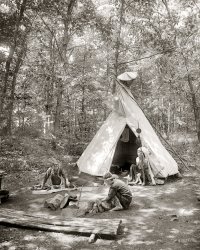
- Tak It Ezy: 1920
- ... he meant Gramma Phone. - Dave]
(The Gallery, Camping, Natl Photo) ... Posted by Dave - 07/12/2014 - 2:44pm -
![Tak It Ezy: 1920 A summer camp circa 1920 in the Washington, D.C., area. View full size. National Photo Company Collection glass negative, Library of Congress.
The good lifeWOW these folks know how to camp. Beds in the tent, a garapahone for music, rocking chair, hammock... Bet they ate well too.
[True. Can't remember the last time I saw a garaphone at a campsite. - Dave]
Ezy Come, Ezy GoWhat an inviting scene, just perfect for the dog days of summer. The porch swing is the crowning touch. I want to go to Camp Tak It Ezy and kik bak!
Music CampPresumably the titanafram is in its own tent out of frame.
IMI guess this means we can add txt spk to the list of things our ancestors discovered long before we did...
It does look like a relaxing getaway, though.
Yeah, but...Just think of all the tiks and snaks. I'll sta hom thanx. (So it was these campers who invented the annoying slacker typing style used so heavily today!)
TypoDave--too many fingers. I meant gramaphone of course.
I know, teacher!It could be a Graphophone, a Graphonola, or a gramophone, but not a "gramaphone."
[Anonymous Tipster is at least getting warm. Maybe he meant Gramma Phone. - Dave]
(The Gallery, Camping, Natl Photo)](https://www.shorpy.com/files/images/31325u.thumbnail.jpg)
- BFF: 1938
- ... his high school class, only three survived the war.
(Camping, WW2) ... Posted by Dave - 04/08/2014 - 1:29pm -
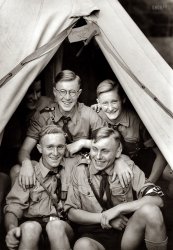
- Danger Lurks: 1908
- ... circa 1908. "Owanoke Prospector's Camp -- Wyndygoul." Camping on the estate of writer-naturalist Ernest Thompson Seton, a founder of ... the era, but I could not see myself dressed like that on a camping trip. Shorts (and bug spray), T-shirt, sneakers would be best.
The ... Posted by Dave - 10/27/2019 - 3:24pm -
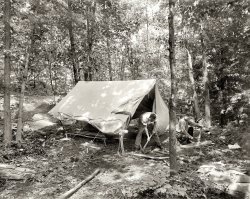
- Happy Campers: 1914
- ... still on the shelves at a PX somewhere.
(The Gallery, Camping, Natl Photo) ... Posted by Dave - 07/12/2014 - 2:44pm -
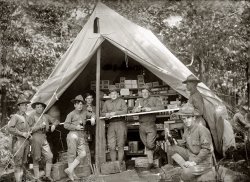
- Summertime: 1936
- ... down.
Are we having fun yet? Even though many camping aficionados continually go on at great length about the liberating and freeing effects of "camping out," I personally would rather stay in a cubicle with indoor plumbing, ... Posted by Dave - 05/16/2009 - 7:06pm -
![Summertime: 1936 August 1936. "Scenes at the auto trailer camp. Dennis Port, Mass." 35mm nitrate negative by Carl Mydans for the Resettlement Administration. View full size.
Film SpeedI thought the film speed would have been quite slow in the mid 1930s, but in order to catch a woman in "mid sneeze" the film would have to be fairly quick.
What would be the equivalent ISO of the film?
[Even 20 years earlier, emulsions were fast enough to freeze a baseball. - Dave]
Gesundheit!Ma seems to be caught in mid-sneeze.
Sure looks like Cape CodLots of scrub pine and lots of sand. What you can't see are the horseflies, greenheads and ticks - but don't let them stop you; the Cape is a Summer fun-derland!
Careful!I think Ma is telling the little one to get away from that rope or everything is going to come tumbling down.
Are we having fun yet?Even though many camping aficionados continually go on at great length about the liberating and freeing effects of "camping out," I personally would rather stay in a cubicle with indoor plumbing, electricity and air conditioning, sheltered from all manner of flying and crawling things, sleep indoors without sharing my bed with nocturnal creatures, snakes, tarantulas and what-have-you and be protected from the wind, rain and other inclement weather. Plus, how long can you look at the sky and sit in a canvas chair, eat canned beans and keep repeating the same conversation. I know we are all different, but for me, camping for more than a few hours would be a severe punishment. It's like saying "hey kids, we are going to pack all our necessities into this big storage bin and go live in the woods like an animal for a while."
Ma...is either knitting or crocheting; I can't see her other hand so I can't tell. Looks like a baby garment of some kind.
Holiday or home?"Resettlement Administration" huh? Was this a camping trip or is this one of the displaced families of the Depression?
[These are people on vacation. - Dave]
(The Gallery, Carl Mydans, Travel & Vacation)](https://www.shorpy.com/files/images/8a02653u.thumbnail.jpg)
- Montana Cowboys: 1939
- ... H
Roundup, Montana
(The Gallery, Arthur Rothstein, Camping, Music, Rural America) ... Posted by Dave - 04/09/2018 - 11:24am -
![Montana Cowboys: 1939 June 1939. Big Horn County, Montana. "Cowhands singing after day's work. Quarter Circle U Ranch roundup." Medium format acetate negative by Arthur Rothstein for the Farm Security Administration. View full size.
Crew cutDid you notice how everybody just had his hair cut. Quite short.
Lighting effectNote also that the photo staged the light cans to give the appearance of campfire. Between the haircuts and the phony set up, this smacks a bit of propaganda.
[There's nothing phony about it. It's one of more than 300 photographs Arthur Rothstein took of cowhands at the Quarter Circle U in 1939. A few examples below. - Dave]
CowboysThis photo is fantastic! Thanks, Dave!
CowboysIt really does look like a movie still.
Cowboy GuitarThat probably is a tenor guitar. These smaller guitars were popular because they're easy to pack along when out on the trail. Nowadays backpackers sometimes carry them. Martin makes a lot of these, and calls them "tenor size." (Elderly Instruments link.)
Light in a canJust curious how these light cans were powered in 1931?
Or are you suggesting it was shot in a studio?
I guess the items that appear to be light cans couldn't be logs on the old campfire...or some other non-staged artifact?
[These were shot outdoors at the Quarter Circle U. The lights were probably powered off a car battery. And the year is 1939, not 1931. - Dave]
Marble Row CountrySmoke 'em if you got 'em.
Can anybody tell if that's a tenor guitar? It looks like it has six strings, but the body's rather small.
Parlor guitarIt's definitely a six-stringer, probably a "parlor guitar" --- a small-bodied instrument made for small venues.
See here: http://tinyurl.com/39lunt
and here: http://tinyurl.com/2gxxt4
WowNothing else to add, just wow!
Home Sweet HomeBeing a native Montanan born on a large sheep spread, this looks very much like home. It really hasn't changed much either, thankfully. I'll certainly never live anywhere else. As my grandfather would have said: "Well, I'll be go to hell, savvy photo ya got there!"
Thanks for the excellent photos, Dave.
Boone H
Roundup, Montana
(The Gallery, Arthur Rothstein, Camping, Music, Rural America)](https://www.shorpy.com/files/images/8b18142u_0.thumbnail.jpg)
- Canoe Club: 1914
- ... there a Hyatt around here? As it is today, 25% love camping, 50% put up with it, and 25% really hate the idea.
Bioplate Wow, ... woman on the right is Ennui d'Istaste.
(The Gallery, Camping, D.C., Natl Photo) ... Posted by Dave - 09/28/2015 - 10:24am -
![Canoe Club: 1914 On the banks of the Potomac circa 1914. "Summer camps: G. Whiz Canoe Club." National Photo Company Collection glass negative. View full size.
Isn't there a Hyatt around here?As it is today, 25% love camping, 50% put up with it, and 25% really hate the idea.
BioplateWow, this one is like a microscope slide but the underlying composition is really great! I can't imagine lugging one of those tents with the heavy canvas and wood supports.
Relationship ConflictI'm trying to figure out if some of those women are the guy's girlfriends or their mothers.
The G Whiz CampI actually found references to this group from the mid 1910's in old DC newspaper articles.
Apparently the G Whiz Canoe Club originated from Camp G Whiz, which was located somewhere about 2 miles north of Aqueduct Bridge.
They made their debut in the Washington Canoe Club Regatta in 1913 or 1914 (the article dated July 17, 1913 didn't specify).
The canoe club pops up a few more times over the next two years, but stopped getting hits in my search through the newspaper archives by 1916, which probably dates the photo to 1913-1915.
[We have dated the other pics in this series as circa 1914, so I think you must be right. - Dave]
Interesting posesThe way the girls' heads are down and their hands placed coquettishly on the chin and the boys' hands on the chairs above them. This is not a formal type photo usually done in that era. It actually somewhat provocative in a way. Wonder why those tents are so close?
Re: RelationshipsMothers or girlfriends? wonders Mr Mel. Are they canoeists, too, perhaps, simply attired less fleshily than the men?
Dare To Be Different!The ladies are striking a fashionably languid pose, a la Vilma Banky, but Sadie is inclining on her "other left."
AtmosphericsThe ravages of time to the negative just heighten the atmosphere of this photo. Gee Whiz, wish we knew more about this motley group.
IronicallyThe name of the woman on the right is Ennui d'Istaste.
(The Gallery, Camping, D.C., Natl Photo)](https://www.shorpy.com/files/images/SHORPY-31326u1.thumbnail.jpg)
- To Build a Fire: 1920
- ... pit is exceedingly dangerous and shows a lack of needed camping skills!
Blazing speed Next installment: We see just how fast the ...
Pressed trousers The reclining chap must be new to camping judging by his neatly pressed dress pants and, as mentioned, the cigar ... Posted by Dave - 10/27/2014 - 11:14am -
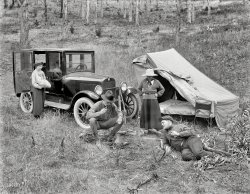
- Texas Roundup: 1901
- ... west" for a few days of pushing cattle, semi-primitive camping, and feasts by Cookie.
Well equipped chuckwagon But does it ... Posted by Dave - 07/20/2012 - 1:38pm -
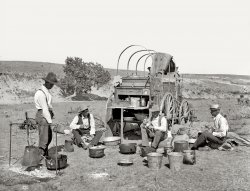
- Royal Spartanette: 1952
- ... not that heavy.
(The Gallery, Kodachromes, Camping, Cars, Trucks, Buses, LOOK) ... Posted by Dave - 01/29/2014 - 5:22pm -
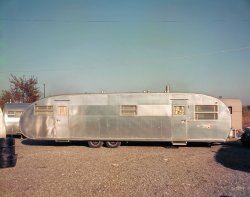
- Klassy Kamp: 1914
- ... clothing sale at 8th and F streets!
(The Gallery, Camping, D.C., Natl Photo, Sports) ... Posted by Dave - 07/12/2014 - 2:59pm -
![Klassy Kamp: 1914 Washington, D.C. (vicinity), 1914. "Summer camps on the Potomac. Klassy Kamp." I think there's probably enough going on in this one picture for a 10-part Ken Burns documentary. Note the Victrola and waterborne equivalent of a Coke machine. The Arlington Bottling sign on the boat advertises "Ginger Ale, Sarsaparilla, Lemon Soda." National Photo glass negative. View full size.
Mixed MediaAmerican flags, Japanese paper lanterns, today's newspaper, and an iPod a Victrola -- Not just Klassy, but Kosmopolitan!
Evening Music
Washington Post, Aug 29, 1915
Society
"Klassy Kamp" on the Potomac was the scene of a pleasant entertainment last Sunday evening, many guests being from Washington and from other camps on the river. The music was the feature of the evening. Messrs. Winnie, Lester, Dudley, Lawrence, Reynolds, Powell and Grimm played guitars and mandolins, after which Messrs, Harry Gillman and Donald Libbey rendered several Hawaiian selections. Supper was served before midnight.
BottlesSeveral of the rustic fenceposts have an empty bottle in front of them ... has anyone any idea of the purpose or significance of these carefully positioned bottles?
[Decorations. - Dave]
Summer eveningsAnything to escape the heat of the city in summer.
That these people were willing to brave the giant mosquitoes of the tidal flats, some as large as pheasants, is a testament to the stifling heat in the days before air-conditioning.
We slept on the porch when I was a kid, and that was in the 60's.
More kool kampsPotomac river camps in 1917. Note the fanciful names. Click image for more.
Re: Summer eveningsThis wouldn't be the tidal Potomac. It looks to be the west bank on the Virginia side where the GW Parkway is now, and upriver from the Aqueduct Bridge.
Mabel W.I've never seen a canoe important enough to garner a name before. I hope Mabel felt honored.
How to spot someone not of our eraThe man in the chaise longue exhibits one of the differences between people now and then: wearing lace-up leather shoes in a casual outdoor setting. No canvas kicks in Kamp Klassy.
Wildlife
How Wonderful!Notice the man in the far back, center... the one with the sailor's cap and in all white. He is so dashing! What a Beautiful picture!
Alternate PerspectiveWell, I just can't get my head around this being on the West bank. Correct me if I'm wrong, but to me it seems we're looking at Rosslyn and Georgetown from the shores of what is now Roosevelt Island. Back then, long after the Mason family abandoned the island, it was used by various groups as a recreational site. Seems possible to me that this was an excursion by the Analstan Boat Club, or something of that ilk. Love the shot! I was born in Georgetown, (when Georgetown was the "slums") and I truly enjoy the looks back to a calmer, saner time.
[These camps were on the Virginia shore of the Potomac. - Dave]
The Newspaper is from June 28, 1914The Sunday Magazine from the Baltimore Sun for June 28th, 1914. With the image entitled "The Tenderfoot" by W. Herbert on the front. Our couple is choosing from one of several titillating articles from that day, such as "Learning A-B-C's at Seventy", "The Woman Who Found Happiness", "Blowing Yourself", "Rozzy, Christmas Angel", "Famous American Duels", and "The Bonehead's Baedeker". And closing out the back page, Canthrox!
Looking at the papers strewn on the groundThe paper the couple bought was actually the Washington Evening Star of June 28, 1914. (The "Sunday Magazine" insert was also in the Baltimore Sun). The image of the woman on the section below their feet is the newly engaged Miss Mary Morris McCauley (to Lt Herbert S. Howard, USN) , and the male image on the paper on the right is an ad from the M. Stein & Co half-price, summer clearance clothing sale at 8th and F streets!
(The Gallery, Camping, D.C., Natl Photo, Sports)](https://www.shorpy.com/files/images/31328u1.thumbnail.jpg)
- The Secret of Scout Camp: 1925
- ... at camp, stays at camp...
(The Gallery, Boy Scouts, Camping, Kids, Natl Photo, Sports) ... Posted by Dave - 07/12/2014 - 3:01pm -
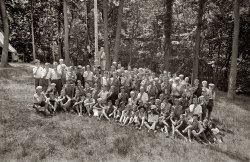
- The Rat Patrol: 1973
- ... wore them in the late 60s early 70s when we started going camping and hiking in the summer. Good shoes to wear for all the rough stuff, ... Posted by AmericanJarhead - 09/12/2011 - 5:55pm -
![The Rat Patrol: 1973 This is my brother Paul (right) with a friend, Danny Bergman, who lived four or five houses down the block. It was taken in 1973 on the driveway in front of our house in Huntington Beach, California. I built the "machine gun" for them from spare pieces of PVC, wood and assorted hardware that were lying around in the garage. Next, I nailed a belt of machine gun ammunition to the block of wood and voila, a "machine gun" ... I used to go hiking with my father up in the dusty hills of Camp Pendleton where I collected spent rounds and belt links from the range. (At the time, I had no clue that I would end up hiking those hills again in 1979 and 1980 as a Marine myself! Or did I?) When I got home, I would reassemble the brass casings with the belt links and make lengthy ammunition belts. In the late sixties and early seventies I always had an ammo can with ten or so feet of belted machine gun rounds. My friends and I played "Army" a lot back in the sixties. Anyway, my brother and his friend would go around playing "Rat Patrol" and blow away all sorts of imaginary suburban enemies. In the garage is my parents 1972 Fiat 124. I never got to drive that thing but it was a dog of a car from what I remember. They ended up replacing the Fiat with a light blue 1975 Volkswagen Rabbit. I learned to drive in the 4-speed manual Rabbit while I had my learning permit. I got my license on the day of my sixteenth birthday and drove the Rabbit until 1976 when it was sold after being involved in an accident. I was not driving it at the time! Scanned from the original 110 negative. View full size.
What goes aroundFantastically good scan from 110 negative! Thanks for sharing, and thank you for your service to this great country.
NiceWouldn't that be Rug Rat Patrol? That's insanely cool, especially with the ammo belt made up from the real thing. The Fiat might've been a dog, but that's a great color for that car.
(Yeah, I asked if you strapped that thing on, but it got edited out. Grr.)
[Part of your comment did not show up because it contained invalid characters. - Dave]
Shocked. Shocked!No helmets? And children allowed to play with toy guns? How times have changed.
Accident Waiting to Happen...As I look at the photo, I can't believe that the gun and my brother didn't fall off and hurt themselves. I don't know how they managed to keep upright!
As for helmets, we rode bikes, skateboards and mini-bikes without helmets because nobody did. I don't remember when the helmet PSA's started appearing but is couldn’t have been too much later than this.
I was surprised at the quality of the scan on this too. Some of the 110 negatives that my mom shot were terrible but this one and several others were most excellent. This was scanned with the Nikon Super Coolscan 5000ED.
I will post some more soon. I have a technical issue which Dave (Shorpy's own) helped me resolve.
Holy Cow!My brother and I used to play Rat Patrol on vacations at the beach back when it wasn't a federal offense to play on the dunes. If we'd had that dune buggy rather than our two spindly legs, we would have destroyed all the sea oats on Topsail Island, NC.
For more Rat Patrol goodness, I give you:
http://www.imdb.com/title/tt0060018/
Fiat GreenI had a Fiat 131 in the same shade, though I think this has printed out a little light. At least in the late 1970s it was closer to glossy olive drab. I had a Rabbit too, later on.
The thing that resonates for me the most, though, is the tank top. That's such a '70s boy's shirt.
Iron-on!Looks like Danny needs some iron-on knee patches. When I was 9 in 1973 I had "Tough-Skin" jeans in assorted colors -- when the knees started to give out my mom would iron on plastic color-matching patches. Which made my knees sweat. And I could never figure out why my jeans never faded like my older brother's.
Oohrah!Yes we played with toy guns and enjoyed Rat Patrol and movies about war.
When we weren't playing with toy guns, we were practicing with real ones. I got my first rifle for my 5th birthday. Didn't get a BB gun until I was 7, maybe 8.
Fun. Italian. Auto. Transport.They started making the Fiat 124 in 1966. The Russian Lada factory is still making a version of it.
Love the wheel chocks, and Yes, my kids have that wagon (in red).
I remember being mocked when my cousin & I pedaled around his block in Cerritos wearing motorcycle helmets.
Also, those are pretty odd shoes for 1970's SoCal, Danny. As I recall, it was pretty much just Converse, Vans, Adidas, Lightning Bolt flip-flips and anything from Sears.
Rat Patrol. Great job of making that machine gun. Always fun to make something cool from a pile of junk. Kids with imagination and skills.
Ever notice in the weekly beginning of "Rat Patrol," the guy absolutely destroys himself on the machine gun as they crest over the sand dune? Ouch.
Also, the lead actor in the series eventually died from injuries incurred while filming the series years later.
Rat PatrolPlaying "Rat Patrol" and "Combat"...Our dads had enough WWII souvenirs (ammo belts, helmets, etc) still lying around in basements and attics that we could kit ourselves out, but I admit we never had such a cool machine gun!
(I always had to be the bad guy because I could speak German).
Fix it again, TonyWe had a nearly identical Fiat, except in powder blue. It was a lemon, and then was squashed like a bug when my neighbor forgot to set his parking brake and his car rolled down the hill, across my lawn and right onto the Fiat.
Not Just a Radio FlyerIt's the flashy Radio Flyer GT, with mag wheels and whitewalls!
Fiat 124, film 110I nearly bought a 124 in 1981, but got another Rabbit instead, the right decision I think. Still cool to see it in the garage there.
Nice job on the 110 scan. So far I've only scanned slides from 110, which are often not very well exposed; I'm hoping I can get better results, maybe comparable to yours, when I get into the negatives.
Thanks for the memories...This picture made my week.
I grew up in the 60s and 70s (turned 10 in 71). I spent most of my childhood on Okinawa, mostly living off base. My brother and I would comb the jungles for WWII surplus (tons of it! Oh how I wish I would have saved some of those treasures) then we'd play "Combat" and "Rat Patrol" with the stuff we found. Getting to play soldier in a sho'nuff Asian jungle ... MAN I loved being a kid.
Avocado see youSome classic 1970s colors here. Wow.
Dart WarsThat suction-cup dart on the ground, what was that from? I love that it's in that same pukey shade of green.
Waffle Stompers!Our kids wore them in the late 60s early 70s when we started going camping and hiking in the summer. Good shoes to wear for all the rough stuff, including going out to the desert to shoot model rockets. (After the rocket landed much time was spent trudging through sand and rocks searching for it.) Practical too. Though they cost more than Vans, they didn't wear out as fast. Plus, they would be outgrown by the next summer, so might as well get use from them.
-- Former SoCal Mom
Field Marshal Rommel beware.Christopher George has nothing on these guys.
Things ChangeGreat photo!
It's interesting to compare this picture to "A Heavy Load: 1909," and meditate on just how much American childhood changed in less than 70 years.
Star Wars Storm TrooperCheck out the shadow of the kid and gun.
Great memory!I was at Camp Pendleton twice, two weeks in 1976 at Devil Pups and again in platoon 3001 MCRD SD 1979.
Great memories of growing up in California!
SameI had a similar toy a friend of my dad built for me in the fifties. He put a motor with a battery and playing card inside so that when I pressed the trigger, we could pretend the noise was the gun firing. Similar to the noise a playing card in bicycle spokes would make.
(ShorpyBlog, Member Gallery, Kids)](https://www.shorpy.com/files/images/paul.thumbnail.jpg)
- Picket Fences: 1905
- ... show a bit more security and privacy.
(The Gallery, Camping, DPC, Travel & Vacation) ... Posted by Dave - 07/12/2014 - 2:54pm -
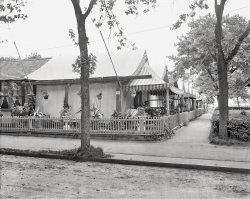
- Meet the Seegers: 1921
- ... Pete Seeger , 2 years old, and family along with their camping rig, last seen here . Harris & Ewing Collection glass negative. ... Increasing rents make no difference in their lives, as a camping place is always available.
Mr. Seeger is the ... Posted by Dave - 01/30/2014 - 11:35am -
![Meet the Seegers: 1921
TRAVEL AND LIVE
IN AN AUTOMOBILE
Charles Seeger, Wife and Three
Sons See World While
Living Outdoors
LIKE WANDERING MINSTRELS
Click here for the rest of the story.
May 1921. Washington, D.C. "Professor Charles Seeger, a composer, is a brother of Alan Seeger, the war poet. His wife is a distinguished violinist." Little Pete Seeger, 2 years old, and family along with their camping rig, last seen here. Harris & Ewing Collection glass negative. View full size.
Pete did discuss the tripResponding to JohnHoward, I spoke with Pete about the trip briefly, but he was eighteen months old when they left in November 1920 and barely 2 years when they got back in May 1921. When I spoke with him he was almost 90, so he really didn't remember it well. His older brother John remembered it better, and tells something about it in this LOC blog post.
There are also accounts in published biographies of Pete's father Charles, who was an important figure in his own right.
Incidentally, the photo up top, with Pete holding Constance's hand, is not the photo that ran with the Washington Post story "Travel and Live in an Automobile."
An Interesting Picturebut it's possible to be more nostalgic about Pete Seeger than he really deserves. He sang functionally pro-Nazi 'pacifist' songs when the Germans and Soviets were allies, but when Hitler invaded the USSR the CPUSA did a right-about-face and Seeger became a war supporter. The guy was basically a tool.
[Or maybe he was an intelligent man of principle who was able to change his mind when the facts warranted. - Dave]
MUSICAL PAIR ON AUTO-HOUSE TOURWashington Post, May 22, 1921.
TRAVEL AND LIVE
IN AN AUTOMOBILE
Charles Seeger, Wife and Three
Sons See World While
Living Outdoors
LIKE WANDERING MINSTRELS
Mrs. Seeger Famed as Violinist.
Husband Professor of Music
In California.
Bound for wherever they happen to stop, paying no attention to daylight saving or other forms of time, and spreading music wherever they go, Mr. and Mrs. Charles Seeger, once of the University of California and now "wandering minstrels" of the world at large, are encamped at Rock Creek park, their home an itinerant Ford and a home-made trailer. They are accompanied by their three little boys.
Mr. and Mrs. Seeger, the latter known in musical circles as Constance Edson Seeger, are taking the boys to museums and places of interest wherever they stop, and the two [older] boys are learning to play the violin.
Going to New England.
The Seegers spent the winter at Pinehurst and are now en route to the New England States for the summer, expecting to go back South when the winter approaches again. Increasing rents make no difference in their lives, as a camping place is always available.
Mr. Seeger is the brother of the famous war poet Alan Seeger, whose "I Have a Rendezvous With Death," written shortly before he died, has become immortal.
Mr. and Mrs. Seeger gave a concert lecture at the Corcoran Art Gallery last night.
WowWas she the first to ever wear a camouflage uniform?
That Old Red Phony SeegerOr maybe, just maybe, Dave he really was a person with a diseased sense of politics who never really got the disease of the soul that he got at a very young age. He may have been a Communist that consumers liked but he still loved that old method of killing off millions and he never, but never, really denounced it.
Bottom line, he liked it.
Oh I think it took him decades to "change" his mind about Stalin.
["Loved that old method of killing millions" -- the bloodthirsty little socialist. Another perspective here. - Dave]
Politics of yesteryear asideGiven the Model T's glacial pace under such a burden, that rig is probably not as much a hazard to navigation and its occupants as it might at first appear.
Just stopCan't we please have one tiny corner of the internet where people aren't constantly spewing their political opinions? Please?
Consider the ironyThis photo was taken in the 1200 block of F Street NW, with the photographer facing northwest. At left is the Homer Building, which occupied the NE corner of 13th and F (as well as the entire 600 block of 13th).
Below is a similar view (from a higher floor & a point further east) from circa 1938. The north side of this block is also visible, in varying degrees, from spots in the 1300 block looking eastward here (alas, obscured by cropping tape) and here (center, in distance, prior to construction of the Homer Building).
Shorpy has previously featured the south side of the 1200 block. Ironically -- and perhaps intentionally -- our gritty travelling minstrels find themselves more or less in front of Erlebacher's and across the street from Rizik's, two stores specializing in high-end fashions.
Where Have All the Flowers Gone?I think all the flowers went on Mrs. Seeger's dress. looks like she might have taken frugality to heart, and made the ensemble from some old curtains. Politics aside, of course.
Uncle Alan SeegerIronically, Uncle Alan couldn’t wait to get to WWI and joined the French Foreign Legion (because the USA was still neutral) so he could fight to save the crowned heads of Europe.
Uncle Alan promptly got himself killed.
I like Pete SeegerAnd I am most definitely on the starboard of his politics. Seeger is a product of his times and family. But the music is American and I like that part.
Did anyone discuss with Pete?I'm curious whether Pete ever saw these photos or talked about the journey with anyone who may have documented their stories?
Granted, at the age of two he was too young to remember it directly but maybe stories were passed down from mom and dad when he got a bit older.
Looking Back Is Grand for CertainPete Seeger carried a card declaring himself a communist, never served his country and made wonderful folk music.
I loved the guy and his music as a Vietnam Marine. Maybe I should have been smarter earlier or maybe he should have been a better banjo player. Either/or I mourn him and salute him. His kind is sorely missed today.
["Never served his country"? Pete Seeger began his Army service in 1942, assigned to duty in the Pacific as an aircraft mechanic. Then reassigned to entertaining the troops. Discharged as a corporal in 1945. - Dave]
I'm With DavePete Seeger has been a National Treasure for my entire lifetime and as Dave has suggested, "He was an intelligent man of principle who was able to change his mind when the facts warranted." I will miss Pete.
(The Gallery, Cars, Trucks, Buses, D.C., Harris + Ewing, Kids, Music)](https://www.shorpy.com/files/images/SHORPY_31241a.thumbnail.jpg)
- Tent Life: 1861
- ... in the new public role of nurse.
(The Gallery, Camping, Civil War, D.C., Kids) ... Posted by Dave - 07/12/2014 - 2:52pm -
![Tent Life: 1861 1861. "Washington, District of Columbia. Tent life of the 31st (later, 82nd) Pennsylvania Infantry at Queen's Farm, vicinity of Fort Slocum." View full size. Wet-plate glass negative, left half of stereo pair, photographer unknown.
Just an old country doctorI'm surprised no one commented yet on that huge saw. It's obviously not a wood cutting implement. Those kind of blades had much bigger teeth to bite into the wood in that day. A precision hacksaw like that was used for amputations, the kind that gave rise to the doctor's nickname "Sawbones," later famously shortened to "Bones".
Queen's Chapel RoadGreat photo. I still can't envision working farmland within the District.
Richard Queen's family operated a 1,000-acre farm that stretched from Rock Creek Church to what is now the Langdon neighborhood in Northeast. Queen's Chapel Road is named after his estate chapel, which serviced the growing Catholic community in Prince George's County and, after 1792, the District of Columbia.
Steam Iron??Is that an iron on the ground (middle, front of picture)? If so, what is the spout for except, perhaps, water? Anybody know?
[The vent in a charcoal iron is for air, not water. A bellows would be attached and pumped every few minutes to keep the coals inside hot. - Dave]
Families?How common was it for soldiers to have their whole families with them? Better yet, WHY were the families with them? Here I was, thinking I knew so much until Shorpy comes along and turns everything I thought I knew on it's head. Thanks!
A Lovely PitcherAmongst all the grittiness, you'll find on the left a beautiful white ceramic pitcher. How long was the exposure time for making photos in this era? You'd expect the children, especially, to be blurry due to their constant movement, but they are almost crystal clear and frozen with expression. Fabulous photo.
[Outdoors, a few seconds. - Dave]
The chest with holesAnyone know what the chest with the holes in it (on the left side of picture) was for? I immediately think of it holding living thing, or maybe bread, but perhaps it's simply for ventilation, so the interior won't get too hot or musty. Anyone know?
[Perhaps a trunk or footlocker for clothes and such. - Dave]
Butcher sawIt is indeed a bone saw, we found a practically identical one from my grandparents' house after they passed away.
I was informed that it was used to cut bones when butchering beef, pigs and game, as my family had no doctors in it.
So this gentleman may have been a camp sawbones, or butcher or maybe simply repurposed a saw he found.
Surgical SawSurgical saws can indeed be that large.
Teeming With WomenLOC annotation for these photos: Princess Agnes Salm-Salm, wife of Prince Felix of Prussia, who served with the Union Army, observed in January 1862 that the winter camp of the Army of the Potomac was "teeming with women." Some wives insisted on staying with their husbands, which may have been the case with this woman, judging by her housewifely pose alongside a soldier, three young children, and a puppy [this photo]. In addition to taking care of her own family, she may have worked as a camp laundress or nurse. Some women who lacked the marital voucher of respectability were presumed to be prostitutes and were periodically ordered out of camp. Only gradually during the four years of the war, and in the face of unspeakable suffering, were women grudgingly accepted by military officials and the general public in the new public role of nurse.
(The Gallery, Camping, Civil War, D.C., Kids)](https://www.shorpy.com/files/images/01666u_0.thumbnail.jpg)
- Canal Point: 1939
- ... Wish we knew what became of them.
(The Gallery, Camping, Florida, M.P. Wolcott) ... Posted by Dave - 07/12/2014 - 2:40pm -
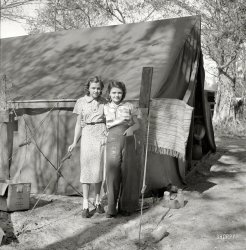
- The Four Blades: 1905
- ... like wax museum figures."
(The Gallery, Adam Maclay, Camping, New Zealand) ... Posted by Dave - 06/06/2014 - 12:10pm -
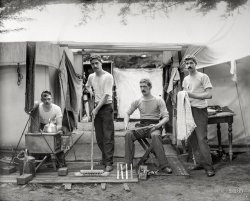
- Model Kitchen: 1919
- ... all day in the kitchen in the middle of summer.
Camping is as close as we get now to what cooking was like for most of the ... Posted by Dave - 09/13/2011 - 8:25pm -
![Model Kitchen: 1919 Washington, D.C., circa 1919. "Goldenberg display, 8th & Pennsylvania Avenue S.E." Note the gas hose on the flatiron. National Photo Co. View full size.
And in the left cornerWe have a much better view of a Hoosier cabinet (mentioned sometime back in another display kitchen). The big glass thing on the right dispenses sugar, and hanging down below the upper door on the left is the flour bin/sifter.
I have seen dream kitchensThis one looks more like a nightmare.
This must bewhere they furnished Alice Kramden's kitchen.
Nothing like a Hoosier!Also called Bakers Cabinets, these wonderful cabinets were a giant step forward in modern working kitchens with their sliding counter tops, built in flour sifters, and sugar bowls with matching jars. This one appears to have a porcelain counter--considered to be very sanitary in a time that people were becoming much more germ conscious. Before porcelain, the counters were zinc.
They still make great cabinets for a kitchen or other use if you can find them at antique stores and shows. You can also get repros. The Sellers brand cabinets were among the nicest made of this type. Most often they were made of oak if unpainted.
This would have beena dream kitchen for most women at the time--a clean gas stove and an oven with a thermostat! So much easier than lighting up wood or coal, waiting for the fire to get hot, but not too hot. No ashes to clean up at the end of the day. No hot stove sitting all day in the kitchen in the middle of summer.
Camping is as close as we get now to what cooking was like for most of the history of the human race!
Hoosier CabinetA high-end example of this key feature of the early 20th century kitchen, at least in my Hoosier farming family ancestry.
My grandmother's is especially vivid in my memory. I can still recall, twenty years after her passing, the aroma from its cache of breadmaking ingredients that wafted out whenever the doors were opened.
The marble pull-out top is where she created all her baked goods. There is a sugar jar on the right and a tilt-out-to-refill flour bin at left (with an in-built sifter).
But Grandma never kept a silver coffee pot in hers.
Making Kitchen Work a PleasureEven though this is a temporary kitchen display, and a pretty charmless one at that, the majority of real kitchens of this period were no better, as seen in several Shorpy photos. Until the late 1920s most American kitchens were still bare and poorly lit rooms with a stove, a sink and a few bits of loose furniture hauled in. Built-in storage and food preparation counters with easily cleaned surfaces, adequate lighting and even overhead fume hoods for stoves were all available from a few architects, but even the very rich were slow to adopt these conveniences. One notable exception was this 1911 kitchen designed by San Diego's early Modernist Irving Gill, for the Nelson Barker residence, seen here with the family's cook, John White, nicknamed "the Duke." Few American kitchens would match its good design until much later.
My Oh My -It's got everything but the kitchen sink.
The Gas ManInteresting that the stove was on loan from The Washington Gas Company. They would have been the local gas utility company like Consolidated Edison in NYC or The Boston Edison Company. The gas and electric companies were the largest vendors of appliances. They had an advantage over the retail stores, they could finance the appliances by adding small payments to the monthly utility bill. $42 for a gas range/oven combo, today the delivery charge would probably be more than that.
Natural Gas Clothes IronThe clothes iron displayed on the kitchen worktable was heated by a natural gas burner inside the iron, as indicated by its flexible cloth-covered hose and gas pipe connector. If there was no gas wall outlet available, such irons could even be connected to an overhead gas chandelier, as were some gas table lamps. Here is another example, found on a vintage appliance dealer's site.
[The stove and iron would have been fired not by natural gas but rather "city gas," also called coal gas. - Dave]
Afraid to light the ovenMy mom was usually a brave and fearless lady, she even evicted a skunk that strayed into our cellar by herself, but in the 1940s she was fearful of lighting our gas oven which was more modern than this one, but it did not have a pilot light, instead it had a quirky gas jet which had to be turned on at the precise moment one held a lit match to it and there was always a burst of flame, a loud "whoosh" and often singed eyebrows and/or dishtowel. She would only use the oven when my father was at home and she would make him light it for her. Yes, he also got his share of burnt arm hair, so I have to assume we had a defective gas oven. Some of us do not realize how easy we have it today, they really were not necessarily the "good old days."
Strange Coffee PotThis coffee pot looks like it is on a tiny pedestal or something. I've never seen anything like it, can anyone enlighten me?
Hoosier CabinetThe Hoosier cabinet was a very sensible addition to the bare kitchens we see in earlier Shorpy kitchen photos. Most people could not afford a designer to make a custom kitchen like the one in the Nelson Barke house. A Hoosier could be found that would fit into the space you had available, and it was (except for the oven and sink) a kitchen workshop extraordinaire. I'd love to have one today.
CoffeepotI'll go out on a limb here and speculate about the coffeepot on a stand. It's a percolator, and they'd be either stovetop or self-heating. There's no sign of an electrical connector, or gas or alcohol burner, so I'll say it's a stovetop, and the round stand looks like it would fit nicely over a gas burner, keeping the pot itself away from the flame to protect it. With an ordinary everyday percolator that always stayed in the kitchen you wouldn't care, but this is a nice one you'd use for company.
(The Gallery, D.C., Kitchens etc., Natl Photo, Stores & Markets)](https://www.shorpy.com/files/images/30685u.thumbnail.jpg)
- Pancho and Lefty: 1902
- ... bread to go There ain't nobody knows.
(The Gallery, Camping, Dogs, Found Photos) ... Posted by Dave - 11/30/2014 - 9:31pm -
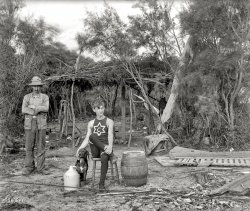
- A Close Shave: 1915
- ... and a teakettle. I've used the same setup when when I go camping.
Cutting-edge He's got one of them newfangled safety razors!
... Posted by Dave - 06/05/2011 - 1:17pm -
![A Close Shave: 1915 Queens County, New York, circa 1915. "Shaving at Broad Channel." Continuing our weekend visit to the cottage colony on Jamaica Bay, Long Island. 5x7 glass negative, George Grantham Bain Collection. View full size.
Hot water!Gotta love water heater. A kerosene stove and a teakettle. I've used the same setup when when I go camping.
Cutting-edgeHe's got one of them newfangled safety razors!
Studio Apt, 25 sq ft, fully furnished.Kitchen and Bathroom in the same room.
And just like the Brady Bunch, no..um... Privy shown.
Hot WaterSeems to be a kerosene/white gas fired burner next to the sink to heat the water that would be in the tea kettle under the sink. The bottle under the table appears to be fuel supply for the burner. Also I am surprised to see that they had wife beater undershirts back in those days. That is a really classic redneck sink brace system.
A Cold Water Flat?Note the kettle under the sink, with some type of heating stove for hot water next to it, as well as the single faucet on the sink. Yeah, we have came a long way, man, where shaving in comfort, at least for most of us, is a foregone conclusion. I remember the days, when I nicked myself more than a few times, using a razor not too far technologically advanced from the one in this picture. OUCH!!
Newfangled indeed!None of those crazy traps on that sink drain, just a straight shot down!
Cold Running WaterA kettle and a Primus stove for heating the cold running water. The stand under the Primus and the burner ring above it are not standard accessories, they look like they solve the chronic problem of balancing a pot on a Primus burner.
The British Army used Primus stoves in WWII and many came onto the surplus market. The very large ones had a nasty habit of splitting at the seams under operating pressure shooting burning fuel in all directions.
Big FeetWhat is that on the molding above the window?
I Love the DetailsThe reclining nude over the window, his eye in the itty bitty medicine cabinet's mirror, the pinecone pull for the shade, the winged faucet handle.
[Or maybe more like scissors. - Dave]
Definitely a kerosene stoveNote the cup at the middle of the generator tube. You filled that with alcohol to pre-heat the generator (or vaporiser, in the UK). This is unnecessary with white gas, which is more volatile. I'd like to have that stove for my collection, but I sure am glad I don't have to burn it in the house.
I also like the straight drainpipe, with no trap. Probably none needed, if it dumped straight into Jamaica Bay!
The VaseI love the vase.
What the?Is that some fertility goddess carving on the ledge behind him? Somehow, it fits.
The doodad over the window.Is that a sculpture of a reclining nude -- with really big feet?!
[Tchotchkologists please identify. Inscription reads "The Sleeping [Beauty?]." Head looks a little like a duck. Cartoon character from the funny pages? - Dave]
The faucetI think that faucet works by squeezing, sort of like a pair of pliers. I've seen very old water fountains with that sort of doodad.
The reclining figure. It’s not a duck-like head but it’s the figure’s right arm folded in a way that her hand stands as a pillow for her face. Yes, certainly must’ve been based on a cartoon. I can imagine it being a birthday gift from his friends. Whether he liked the cartoon or because they mocked him on being a sleepyhead. Don’t blame me if I fill the blanks with a lot of perhaps...
Progress?Just because the razors mass marketed today have more blades than I have fingers on my hand, doesn't make them better. In 1915, the razor this guy is using is probably a Gillette Old Type or Single Ring, a razor any collector would love to have, and any man who loves his face should LOVE to shave with. If you get past the marketing hype and explore the history of these razors, you might find yourself in for bit of a treat.
(The Gallery, G.G. Bain, NYC)](https://www.shorpy.com/files/images/19855u.thumbnail.jpg)
- Wyndygoul War Dance: 1908
- ... people dancing and enjoying.
(The Gallery, Boy Scouts, Camping, G.G. Bain, Sports) ... Posted by Dave - 07/12/2014 - 2:27pm -
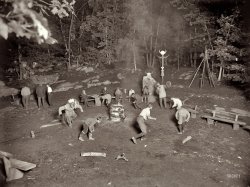
- All the Comforts of Home: 1915
- ... showing a washing basin, pots and teapot with cups of tea, camping ground unidentified, possibly Christchurch district." Glass negative by ...
Great old photo!
(The Gallery, Adam Maclay, Camping, New Zealand) ... Posted by Dave - 10/19/2013 - 12:11pm -
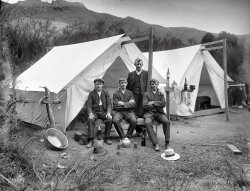
- End of the Line: 1921
- ... really desire a structure like this. Is it a vacation / camping cottage? Perhaps a transportation historian can tell us whether ... Posted by Dave - 09/13/2011 - 1:42pm -
![End of the Line: 1921 July 15, 1921. Washington, D.C., or vicinity. "House of street cars." National Photo Company Collection glass negative. View full size.
Street Car SmithWhen the Pacific Electric Red Car line was torn out in Los Angeles, a man named Smith bought about eight of the old trolleys and brought them up to a large parcel that he owned in the northern San Fernando Valley. He strung them together with short corridors between each car, using one as a kitchen, one as a family room, several as bedrooms etc. He and his wife raised a family there. When he retired, or died, in the 70s, the property was sold and the streetcars were demolished. I, too, wish I had a picture. I did wander through the cars before the wrecker showed up. It seemed that their living accommodations were quite nice and cozy.
So CoolI wonder if the place still exists?
Street car afterlifeIn the 1940's in Denver, when trolley cars were replaced by buses, the old cars were available cheap. My friend's father got two and made a cabin near Evergreen.
Terrific!What a fantastic house! Complete with rocking chair on the porch -- I'd love to live in it. Is it still standing? How did they get the streetcars up onto the hill, I wonder? (And what's that thing in the bushes, to the left of the porch?)
San Diego StreetcarsThis streetcar home reminds me of the following photo: former San Diego streetcars converted to housing (circa 1941). On the hill in the background is the Serra Museum and Presidio Park - site of the first European settlement on the west coast.
Delighting the Streetcar GeekKudos for adaptive re-use, even if this structure didn't last very long. According to the out-of-print "100 years of Capital Traction" by Leroy O. King Sr., electric streetcar service in Washington D.C. began on October 17, 1888 with the inauguration of the Eckington & Soldier's Home line. A photo on page 19 of that book shows a five-windowed car identical to these in a photo taken on that first day of operations. We can only guess the location of this Shorpy photo. Given the hilly location, this site may overlook the Potomac River immediately west of Georgetown University. A trolley car barn was located there (not to be confused with the massive structure at 36th and M Streets which still exists, opposite Key Bridge).
Birth of a NotionWay down east, to circumvent to horse-drawn lunch wagon restrictions, obsolete street cars were purchased on the cheap and placed on foundations. The beginning of what became the "diner."
Would desireWhat a cool merger of materials — I'd really desire a structure like this. Is it a vacation / camping cottage? Perhaps a transportation historian can tell us whether streetcars are lighter than one would think, because I'd also be keen to know how the builder transported the cars to that wooded spot and set them in place. Thanks.
Half and halfI wonder, could this be one car cut in half? They seem rather short otherwise.
This placegives me the willies.
Mystery object in the bushesCan anyone tell what this is?
[Colloquially and anatomically speaking, a horse's ass. - Dave]
Bon appetitWhen last I was through Buellton, California, early this year this restaurant based on two 1911 dining cars was still standing. The owner hoping that the local historical society would have it moved before commercial development brought it down.
[Another commenter replies: These are former Los Angeles Railway streetcars in the color photo, not dining cars. - Dave]
A hint as to provenance"W. RY & E Co."
[Washington Railway & Electric! Good eye you have there. - Dave]
Streetcar detailsI'm not a "transport historian", but I'm involved with the restoration and running of old streetcars at a tramway museum, so I have practical experience with vehicles of this era. The bodies of these cars would be relatively light, not much more than a ton or so. For comparison, this photo of mine shows a car of a similar vintage, though somewhat larger. Its carbody alone weighs 1.75 tons. Early electric streetcar design borrowed heavily from horsecar and cablecar design, where the emphasis was on light weight and durability.
The weight of old streetcars was in the mechanical/electrical components - the truck, wheelsets, traction motors, brake rigging, controllers, resistors, trolleypoles and compressor if fitted with air brake. Once you remove all these components, as is the case with these two cars, you're left with a fairly light structure which would easily be moved on the back of a horse-drawn jinker, and just as easily lifted with a block, tackle and an a-frame. Or you could just use jacks and block the car up onto the piles. I've had to move carbodies without much in the way of lifting gear, it's not hard.
The original photo shows two carbodies, not one cut in half as was suggested previously. Notice the grabiron on right-hand end of the carbody at window level, and the platform bearer below the rocker panel. Neither of these would be present in the middle of a longer car cut in half.
(The Gallery, Curiosities, D.C., Natl Photo, Streetcars)](https://www.shorpy.com/files/images/29978u.thumbnail.jpg)
- Fight for Freedom: 1943
- ... of a patch, it would be obscured by what appears to be a camping contest medal. He also has a 1942 Camporee patch on his right shirt ... I also think that the medal he is wearing is not a camping medal, but is - in fact - the older style of the Islamic "God and ... Posted by Dave - 07/17/2012 - 10:11pm -
![Fight for Freedom: 1943 Washington, 1943. "United Nations Fight for Freedom: Colored, white and Chinese Boy Scouts in front of Capitol. They help out by delivering posters to help the war effort." View full size. 4x5 Kodachrome transparency by John Rous for the Office of War Information. What photo expert out there can tell us about the numbers on these Kodachromes -- how and at what point in the manufacturing/ exposure/ developing process they were made, and what they signify.
The numbersI know that the numbers are exposed during manufacture. however I don't know what they mean.
The notches at the top are the "notch code" which tells you what brand and ISO film you're using. I'm not an expert, i'm just taking a large format class right now.
[The numbers aren't "exposed." On this example they are holes punched in a little piece of paper, covering up a hole in the film. There is what looks like a date (N 28 1943) stamped in ink under the 22. Another frame from this shoot, showing just one scout, also has the number 22 on it. On other 4x5 Kodachromes the numbers are clear dots in the emulsion itself and there is no little piece of paper and no date. - Dave]
Numbers on filmThese numbers are exposed on the rebate of the film by a specially modified, or factory made 4x5 film holder at the time the original shot was taken. This is quite common, and several manufacturers made film holders that would allow for this, as well as many photographers modified their existing film holders to identify individual frames. These Kodachrome transparencies are 4x5" individual sheets of film, not a "roll" of film. The Individual 4x5 sheets of film had to be loaded into film holders in the dark by the photographer before his assignment. No 4x5 film has ever had factory applied numbers other than for film type, and these numbers are not relating to film type.
The PosterClick to enlarge.
Number on printI'm going to guess the numbers come from the film strip itself. This is the 22nd exposure on the roll. At the very least that makes sense to me as 35mm film has similar numbers on it to this day...
[There is no roll. This is sheet film. And this isn't a print, it's a transparency. - Dave]
Boy ScoutsThis is a great Boy Scout picture! As a former Eagle Scout I am happy to see it.
The young man on the right is wearing a pin on his left pocket indicating that he is a Life Scout, the rank just below Eagle Scout. The two bar patch on his left arm shows that he is a Patrol leader. The red white and blue cord on his shirt is a service award indicating that he was a "Den Chief" for more than a year. A Den Chief is an older Boy Scout who mentors Cub Scouts. He appears to have two "service stars" indicating the number of years that he was in the Boy Scouts or Cub Scouts. He is from Troop 11 in Washington DC according to his shoulder patches.
The boy on the left has no rank that I can discern, but if he is wearing a pin instead of a patch, it would be obscured by what appears to be a camping contest medal. He also has a 1942 Camporee patch on his right shirt pocket.
He also is from DC but from a different troop, starting with a 5
Unfortunately, since they are saluting, I can't tell you what patrol they were in.
I was kind of surprised to see the Pin on the Life Scout rather than a patch, But I suppose during the war the demands for Army uniforms was higher on the production boards lists than Boy Scout uniforms.
KodachromeThe row of dots along the bottom are marks left by the film holder used in development.
Gene is correct, the yellow square with 22 and other info is indeed from a user supplied 'ID' exposed into the film.
The notches on the upper left are the notch code identifying the emulsion for loading in the dark.
The pantsI wonder if the war period was the transition between the knicker-type scout pants of the 30s and regular trousers. My dad was a scout in the 30s and wore the knickers. Here the two on the left look like their socks are just pulled up over their cuffs, while the Chinese scout is wearing last year's too-short pants. Note also the uniforms are different shades of khaki - perhaps due to reusing older uniforms or having to use various fabric sources during the war.
Photographer John RousThe photographer is my uncle, now deceased, but I have many of his photographs, 2 scrapbooks compiled by his wife, Connie Hicks Rous. I also have his ID card from the war department. John Rous later worked for the Associated Press covering the White House.
I have just discovered this site today and will see what how I can contribute more of his work.
Eagle Scout hereDPatten, Thanks for the analysis. I have one of those Life Scout pins. The Scout on the left has a "Senior Scout BSA" patch over his left pocket. I have to check my 1942 Boy Scout Handbook. Wasn't the braid for Den Chief a loop hanging from the right shoulder around the right arm? That was the case when I was in the Scouts 1968-1978. This braid seems to be a whistle lanyard.
InsigniaCouple of things I've noticed. First, the boy on the left - identified as "colored" - is actually, I believe, of Filipino heritage. I also think that the medal he is wearing is not a camping medal, but is - in fact - the older style of the Islamic "God and Country" award ("In the Name of God", as it's called now), which would fit in with the boy being Filipino. Also, despite his shorter stature, the patch above his pocket identifies him as being a "Senior Scout" - the predecessor to the 1950s' "Explorer Scout", or today's Venturer - meaning that he was at least 15, at the time. This may also explain why he, and the boy in the middle, appear to have lighter-color uniforms, and the difference in the trouser legs. The Scout on the right, by contrast, can be seen to lack the "Senior Scout" patch on his uniform, meaning that he is 14 or less (the "up-grade" at 15 was automatic), which would tie in with the two single-year pins on his uniform. The cord is not a Den Chief's cord - which would be blue and gold and worn on the shoulder - but is probably, as someone has suggested, a whistle lanyard; this would tie in with his Patrol Leader insignia.
(The Gallery, Kodachromes, Boy Scouts, D.C., WW2)](https://www.shorpy.com/files/images/1a35389u.thumbnail.jpg)
- Lenny and Edna: 1924
- ... I was thinking of the episode where Beaver and Gilbert go camping, get stuck on a ledge and are rescued by park rangers. - Dave]
... Posted by Dave - 08/13/2012 - 6:08pm -
![Lenny and Edna: 1924 June 3, 1924. "Leonard and Edna Wilbur," children of Navy Secretary Curtis Wilbur. National Photo Company Collection glass negative. View full size.
Edna & OnaFrom the Lima (Ohio) News, April 9, 1928:
Rescued by forest rangers from a narrow ledge 2,000 feet high, where darkness had trapped her and her girl companion during a trip thru Yosemite valley, Miss Edna May Wilbur, daughter of Secretary of the Navy Curtis D. Wilbur, was home here none the worse for her thrilling experience. Miss Wilbur went to the park with a party of friends. She and Miss Ona E. Ring attempted late Saturday to descend the snow-covered trail from Glacier point to the floor of the valley. Caught by darkness, they lost the trail and presently found themselves on the narrow ledge, whence they feared to attempt further progress. With a biting mountain wind tugging at their clothing, the girls huddled against the face of the cliff and called for help. Tourists in the valley, 2,000 feet below, heard their cries, and notified the forest rangers. Five men reached the girls shortly before midnight, and strenuous efforts succeeded in hauling them up to the trail with ropes.
[Thrilling! I think this was an episode of "Leave It to Beaver." - Dave]
Tats or Vacs?Those circular things on her arms. Can I assume that they were vaccination scars? She certainly has a modern attitude or so it seems.
[That's mold on the emulsion. - Dave]
Yes, DaveYes, the episode wherein the Beav climbs into a teacup and can't climb out and is rescued by the fire department. Amazing how daring Miss Wilbur was - that explains the dress.
[Not quite. I was thinking of the episode where Beaver and Gilbert go camping, get stuck on a ledge and are rescued by park rangers. - Dave]
Still waters run deepMiss Edna has a certain sly gleam in her eye. I'll bet she danced a few Charlestons in her time while Dad was off minding the boats.
Edna Does D.C.Atlanta Constitution, 11 July 1924
New Cabinet Daughter
Lands in Capital
And Looks it Over
Washington's newest cabinet daughter has been spending her first few days in the capital just like anybody's daughter here on an excursion trip -sightseeing.
Miss Edna Wilbur, whose father is secretary of the navy, arrived last Thursday from California. She came through the Panama canal with her brother, Leonard Wilbur, and then up the Chesapeake bay and the Potomac, from Hampton Roads, on the neat little yacht Sylph, which is at her father's disposal as boss of the navy.
...
Miss Wilbur is Washington's third cabinet daughter of marriageable or debutante age. Both the other two aren't braving hot weather here.
...
Miss Wilbur has another cabinet distinction besides braving Washington heat. She's the only daughter of a cabinet member who knows how it feels to spend money earned by herself.
The daughter of the navy secretary is a California high school teacher and she didn't give up her job just because her father is a member of President Coolidge's cabinet ...
Miss Wilbur is a tall girl, with much pale yellow hair and a fair skin. Not pretty, but attractive looking. And not the debutante or flapper type.
She is quiet and self-possessed. She has the voice and manner of a successful teacher.
And --no, her hair is not bobbed!
A Boston Globe article from April 13, 1924 says Edna graduated from Stanford with a degree in French. She was teaching at Chico High School.
Leonard or Lyman, perhaps Paul?I've been doing some research on Curtis Wilbur and all the sites list his children as Edna, Paul and Lyman. Perhaps Leonard was a nickname or is this a typo?
[Leonard Wilbur's name makes dozens of appearances in the historical archives of various newspapers. See the next comment up. - Dave]
Dr. Leonard Wilbur's mission Young Leonard would lead an inspiring, but all too short, life. After graduating from medical school at Stanford (where his uncle had been a president) he and his wife embarked upon a mission to Northern China, starting a hospital in the province now known as Shanxi. First the communist insurgents invaded (and the Wilburs were reported missing) in 1936. They resurfaced, but in late 1937 the Japanese invaded Shanxi (and the Wilburs were again reported missing but resurfaced). On Easter in 1940, during the Japanese occupation, Leonard died of typhus. He was only 33. His wife survived, and became one of the heirs to father-in-law Curtis Wilbur's inheritence when he died in 1954.
Sorry, Miss Edna.I guess you weren't the flapper I took you to be. The sly gleam must have been that look you gave your students to let them know you meant business.
Wilbur childrenCurtis D Wilbur had 5 children...
1. Ralph 3/18/1903 - 3/24/1906 age ~3
2. Leonard 3/2/1907 - 3/24/1940 age 33.
3. Edna was 25 in this photo, and Leonard 17.
From Pathways: A Story of Trails and Men (1968) by John W. Bingaman--
The Ledge Trail: "In 1871, James M. Hutchings had been guiding parties of hikers to Glacier Point over a most hazardous trail, which he had blazed up the Ledge and through the chimney and which climbed 3,200 feet in approximately one and a half miles to Glacier Point. This was the Ledge Trail.
In 1918, it was repaired by the Park Service. It was a dangerous climb because it was partly built of solid rock, and extremely steep, much like a staircase. Rock slides occurred frequently causing accidents to climbers. Only up-travel was permitted by the park regulations in later years. After several major floods, rock slides, injuries, and deaths to climbers the park authorities deemed it necessary to close this trail to all hikers. The Author assisted in rescue parties several times on this trail."
Edna hiked the Sierra's of California until she was 90.
4 & 5. Paul and Lyman lived until they were 100.
(The Gallery, D.C., Natl Photo)](https://www.shorpy.com/files/images/11692u.thumbnail.jpg)























